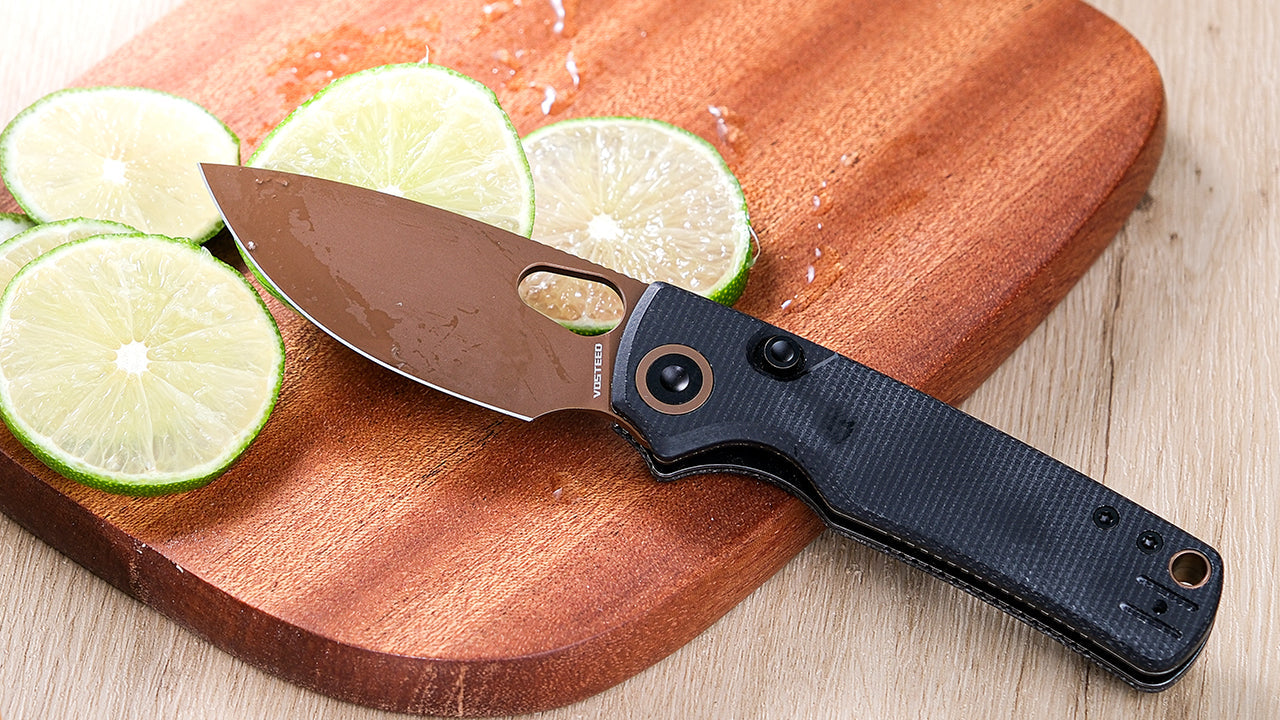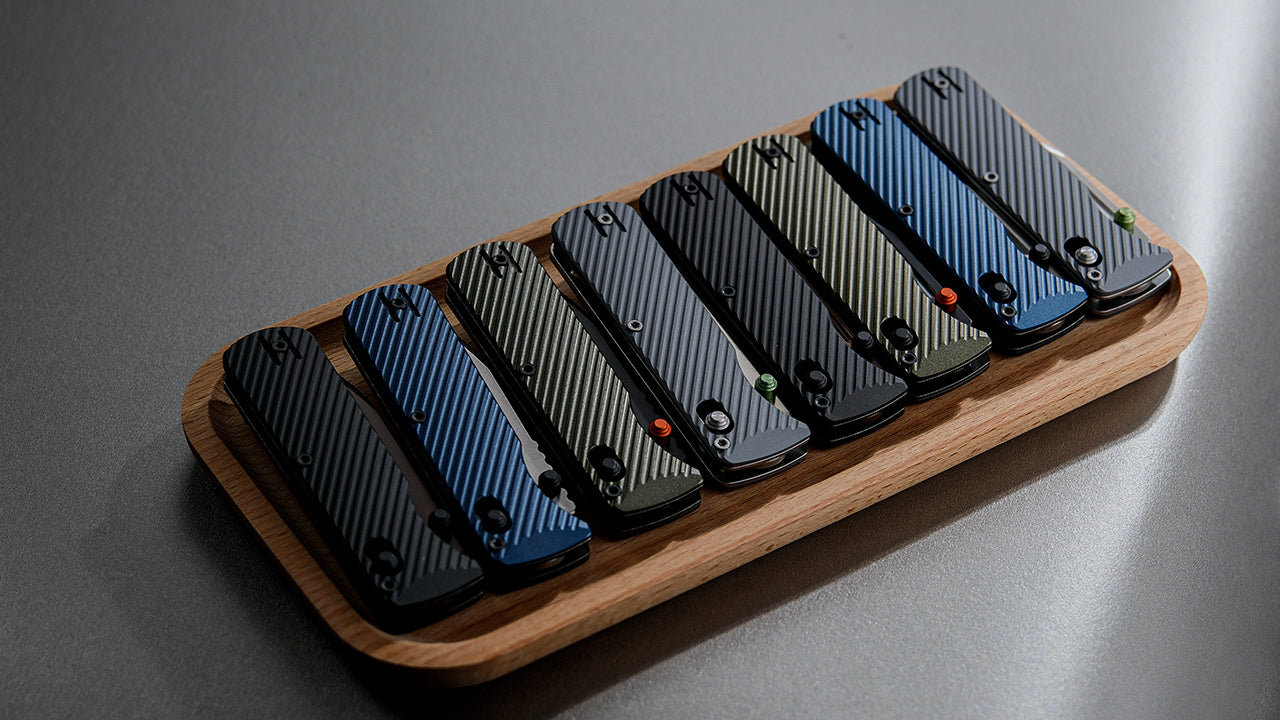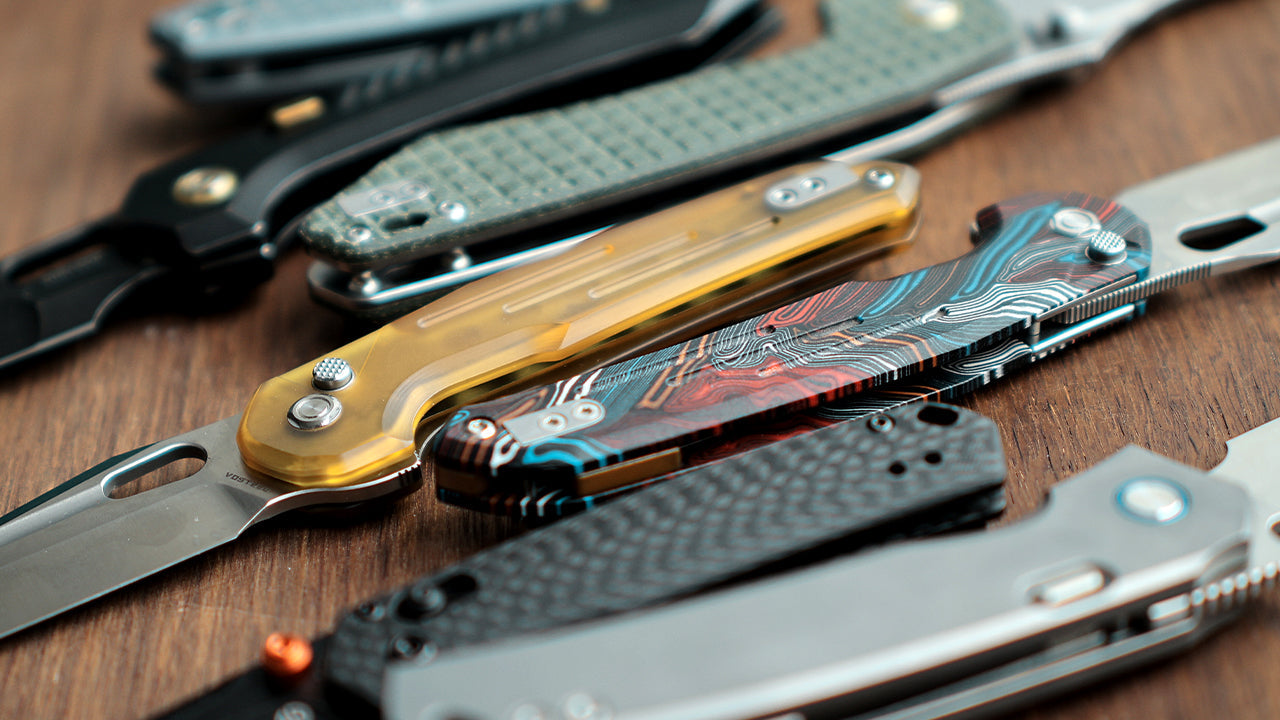If you're new to pocket knives, all the options and features may overwhelm you. Following is a simplified guide to all that you should know, from choosing the right knife to the features that make a knife great.
Why Carry a Pocket Knife? Everyday Uses and Benefits
A pocket knife is much more than just a knife—it's an assistant for all sorts of everyday tasks. From opening boxes and slicing food on camping trips to making minor repairs, a pocket knife comes in handy. In the great outdoors or simply working around the home, a solid pocket knife is a good investment.
Carrying a knife promotes self-reliance and preparedness. It gives you a solution to common problems without needing to run to the store for tools. Additionally, pocket knives are compact and lightweight, and they are convenient to keep in your purse or pocket.
Myths and Misconceptions About Pocket Knives
Many people are hesitant to try pocket knives, possibly due to misconceptions about them; But once you begin to use a pocket knife, you'll experience its convenience firsthand:
They are Only for Self-Defense?
Many believe that pocket knives are primarily designed for self-defense, but in reality, they are versatile tools meant for everyday tasks. From opening packages to preparing food, most folding knives are used for practical purposes, not as weapons.
They Will Always Rust?
Not necessarily. Modern pocket knives, especially those made from stainless steel, are resistant to rust. With proper maintenance, such as cleaning and drying the blade after use, you can keep your knife in great condition.
Pocket Knives are just all the Same?
No, pocket knives come in many different types, each designed for specific tasks. Some are made for general use, while others are specialized for activities like fishing or hunting. If fishing is your passion or a frequent pastime, you'll find that mastering the art of selecting the right fishing knife can significantly upgrade your gear and preparedness.
When Not to Carry a Pocket Knife
Understanding when not to carry a knife is just as important as knowing how to choose the right one.
Though it may be handy to carry a pocket knife, there are some locations where it is inappropriate or illegal to do so. Make sure to familiarize yourself with your local laws before carrying a knife. Some locations may prohibit knives with automatic opening features, or blades exceeding a specific length.
Also, keep in mind that not all environments are knife-carrying friendly. Some public gatherings, workplaces, and schools may have a no-knife policy, so always be mindful of the environment.
| When Not to Carry a Pocket Knife | Reason |
| Restricted Areas | Many places like airports or schools prohibit knives. |
| Social Settings | Can be seen as inappropriate or alarming. |
| Certain Countries | Strict knife laws may lead to legal issues. |
| Public Events/Protests | Can raise security concerns. |
| Lack of Safety Knowledge | If unsure about handling, better to leave it. |
Key Features to Consider When Buying Your First Pocket Knife
When choosing your first pocket knife, there are some things to consider. Here is what to look for:
Blade Types and Shapes
There are some blade shapes that are suited for different tasks. Some of the common shapes include:

| Blade Type/Shape | Description | Best For |
| Drop Point | A versatile blade with a convex curve and a lowered point. | General use, slicing, and precision cutting. |
| Clip Point | Features a concave curve and a pointed tip for better control. | Detailed work, piercing, and fine cuts. |
| Straight Back | A blade with a straight spine and no curve. | Everyday tasks, cutting, and utility. |
| Spear Point | Symmetrical shape with a point in the center, great for precision. | Detailed cuts and piercing tasks. |
| Tanto | A blade with a flat tip and angular point for durability. | Heavy-duty tasks, cutting through tough materials. |
| Reverse Tanto | A blade with a flat edge and an angled, reinforced tip. | Strong tip control, piercing, and utility tasks. |
| Sheepsfoot | A blade with a rounded tip and straight edge. | Cutting, especially for food or ropes, where precision is key. |
| Wharncliffe | Similar to a sheepsfoot, but with a straighter edge and more acute tip. | Precision tasks, opening packages, and cutting in tight spaces. |
| Shilin Cutter | A traditional Taiwanese folding knife with a gently curved belly and narrow point. | Everyday use, slicing, and fine detail work. |
| Cleaver | A wide, rectangular blade with a straight edge. | Chopping, heavy-duty cuts, and food prep. |
| Serrated | Blade with a serrated edge for cutting through tougher materials like rope. | Cutting through fabric, rope, or cardboard. |
| Full Flat Grind | Blade with a flat edge, offering a thin, sharp edge. | General cutting tasks, slicing, and clean cuts. |
| Hollow Grind | Features a concave shape for a sharper, more precise edge. | Fine cutting and detailed work. |
While this table offers a solid overview of various types, a deeper visual dive into the most common blade profiles can further clarify their specific advantages and applications.
Blade Materials: The Heart of Your Knife
The material of your knife's blade is crucial. It directly impacts the knife's sharpness, how long it stays sharp (edge retention), its ability to resist chipping or breaking (toughness), its resistance to rust (corrosion resistance), and how easy it is to resharpen. For beginners, blade materials can generally be grouped into these main categories:
| Material Type | Description | Pros | Cons |
|---|---|---|---|
| Stainless Steel | Contains chromium (typically 13% or more) to resist rust and corrosion. A broad category with varying performance levels; many modern stainless steels offer a good balance of properties. | Excellent corrosion resistance, generally low maintenance. Many modern stainless steels offer a good balance of edge retention, toughness, and are relatively easy to sharpen. | Can be harder to sharpen than carbon steels, especially very hard, high-performance "super steels." Top-tier stainless options can be more expensive. |
| Carbon Steel | Lacks significant chromium, known for taking a very fine edge and being relatively easy to sharpen. A traditional choice for knife blades, requires diligent care. | Achieves high levels of sharpness, often has good edge retention for its cost, generally easier to sharpen than many stainless steels. | Prone to rust and discoloration if not properly cared for (must be kept clean, dry, and often oiled). Requires more maintenance. |
|
(High-Carbon) Tool Steel (e.g., D2 Steel) |
A category of steels originally designed for industrial tools, often valued for high hardness, wear resistance, and toughness. | Can offer excellent toughness and edge-holding for demanding tasks. Often a good performance-to-cost ratio. | Many are not fully "stainless" and will require care to prevent rust, though often more resistant than simple carbon steels. Can sometimes be more challenging to sharpen. |
Handle Materials: G10, Carbon Fiber, Titanium, and More
In addition to blade materials, the handle material plays a big role in the knife’s overall performance.

The material of the handle determines the durability, weight, and comfort of the knife. Some of the common materials used are:
| Material | Key Characteristics | Pros | Cons |
| G10 | Durable fiberglass laminate with a textured surface. | Strong, affordable, excellent grip, resistant to impact. | Heavier than carbon fiber, can be rough on the hands if not finished properly. |
| Carbon Fiber | Lightweight, strong, and sleek with a modern look. | Very lightweight, strong, and visually appealing. | Expensive, can be brittle under extreme stress. |
| Titanium | Strong, corrosion-resistant metal. | Lightweight, highly durable, and resistant to rust/corrosion. | More expensive than G10, can be harder to work with for detailed finishes. |
| Micarta | Resin-impregnated fabric composite. | Grippy even when wet, durable, warm feel in hand. | Can absorb moisture if not sealed, surface may wear over time. |
| Aluminum | Lightweight metal, often anodized for color. | Lightweight, affordable, good strength-to-weight ratio. | Can feel cold or slippery, may scratch more easily than other materials. |
Ultimately, the right choice depends on your specific preferences and how you'll use your knife; exploring a detailed comparison of knife handle materials can guide you in finding that perfect match for either a pocket knife or a fixed blade.
Locking Mechanisms
A good locking mechanism keeps the blade secure when in use. Some of the common mechanisms are:

| Lock Type | Description | Pros | Cons |
| Liner Lock | A spring-loaded bar inside the handle that locks the blade in place. | Simple, easy to use, and reliable. | May wear down over time, reducing strength. |
| Top Liner Lock | A variation of the compression lock, using the top liner to secure the blade. | Strong, secure, and easy to operate with one hand. | Slightly more complex than standard liner locks. |
| Vanchor Lock® | A patented hybrid lock with a top-mounted plate and internal pin system. | Ambidextrous, smooth action, very stable and strong. | Proprietary design, only found in specific models. |
| Crossbar Lock | A spring-loaded bar across the handle that secures the blade from both sides. | Easy one-hand operation, ambidextrous, smooth action. | Can wear over time, more moving parts than simpler locks. |
| Frame Lock | Uses a metal frame of the handle to secure the blade. | Stronger than liner locks, offers durability. | May be harder to unlock with one hand. |
| Back Lock | A spring mechanism in the back of the handle that locks the blade. | Very secure and stable, great for heavy-duty use. | Can be difficult to unlock, especially with one hand. |
| Button Lock | A button on the handle that releases the lock when pressed. | Quick and easy to operate, good for one-handed use. | Can be prone to failure if the button gets damaged. |
| Slip Joint | A traditional, non-locking mechanism where the blade is held by friction. | Lightweight, compact, and simple design. | No locking mechanism, so it’s less secure. |
| Rotary Lock | A rotating collar around the blade’s pivot point that locks the blade in place. It is mostly used by Opinel Knives | Easy to be made, great for simple wood or bush craft folding knives. | Can be difficult to operate quickly, not as smooth as other locks. |
Indeed, knowing these lock mechanisms provides a great starting point; however, for those aiming to grasp the essential secrets behind reliable blade safety and to find recommendations for knives with superior lock performance, a more in-depth exploration often proves invaluable.
Opening Mechanisms
Different knives have different means of opening the blade. Some of the most popular ones are:
| Mechanism | Description | Pros | Cons |
| Thumb Stud | A small nub on the blade that allows the user to open the knife using their thumb. | Simple, easy to use, can be operated with one hand. | Requires some dexterity to open smoothly. |
| Thumb Hole | A round hole in the blade that allows for opening with the thumb. | Easy to use, works well for both right and left-handed users. | Can be difficult for users with smaller hands. |
| Wheeler | A roller-style opener inspired by lighter wheels, featuring a deeply jimped surface for controlled thumb rolling. | Unique and fun, offers excellent traction and intuitive operation. | Newer design, may take some getting used to for beginners. |
| Flipper | A small tab that protrudes from the back of the blade, which you flip to open. | Fast and easy one-handed opening, smooth action. | Can be harder to operate for people with small hands. |
| Assist Spring | A spring mechanism that helps open the blade once the user starts the motion. | Quick and smooth opening, can be operated one-handed. | Often requires more maintenance and may wear out over time. |
| Button Push | A button on the handle that when pressed, releases a spring mechanism to open the blade. | Fast and easy, often combined with other safety features. | Can malfunction if the button is damaged. |
| Automatic (Switchblade) | A button or switch on the handle that automatically deploys the blade when pressed. | Instant opening with a push of a button, fast deployment. | Illegal in many areas, can be dangerous if not handled properly. |
| Dual Action | A combination of a thumb stud and a spring-assisted mechanism. | Dual functionality, both manual and assisted opening. | More complex design, higher cost. |
| Pivot Lock | A mechanism that locks the blade in place when it is fully deployed. | Secure locking, smooth opening. | Requires both hands to open, not always practical for quick deployment. |
Size, Weight, and Carry Options
The size and weight of the knife determine carry ease. A smaller knife may be easier to carry on a daily basis, and a larger knife may be appropriate for heavy use. Pocket clips or lanyards are also included on most knives for easy carry. This often leads to the crucial question of what specific dimensions best suit an individual's daily needs.
How Much Should You Spend? Budgeting for Your First Knife
The price of a pocket knife will range from under $50 to over $300. As a beginner, it's ideal to spend relatively little, around $50-$100, on something that will provide a good balance of quality and price. As you learn more about pocket knives, you can spend money on higher-priced versions.
5 Pocket Knife Safety Tips for Beginners
- Always cut away from your body.
- Keep your fingers clear of the blade when opening and closing it.
- Use the locking mechanism properly to avoid accidental closing.
- Store the knife securely when not in use, especially out of reach of children.
- Keep the blade sharp to ensure it performs well and reduces the risk of accidents.
Frequently Asked Questions about Pocket Knives Choose
How do I select the appropriate pocket knife size?
The knife's size will depend on your intended use. A medium-sized knife is sufficient for ordinary everyday tasks. If you will be using it for heavy-duty tasks, a larger knife with a thicker blade may be preferable.
What's the best blade material for everyday use?
Stainless steel is the most common for everyday use because it has corrosion resistance and is easy to maintain.
How do I sharpen and care for my pocket knife?
Regular cleaning and sharpening are the secrets to maintaining your knife's health. A sharpening stone or guided sharpener will maintain the edge, and wiping the blade clean after each use will stop rust from forming.
Are pocket knives legal everywhere?
No, pocket knives are subject to local law. There are a few places that have laws regarding blade length, locking mechanisms, and carry methods. Always review the laws in your area prior to carrying a knife.
The Right Pocket Knife for You: Final Advice & What's Next
It all changes with the right pocket knife. Whether you need it for outdoor activities or basic chores at home, knowing the options, characteristics, and safety precautions guarantees you choose correctly. Begin your adventure with a pocket knife in confidence—pick one that suits you, and never forget safety and maintenance.





Leave a comment
All comments are moderated before being published.
This site is protected by hCaptcha and the hCaptcha Privacy Policy and Terms of Service apply.